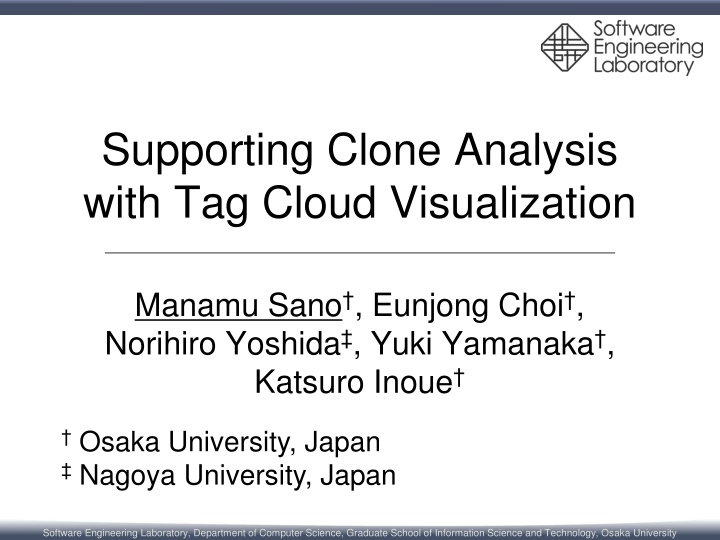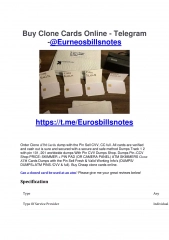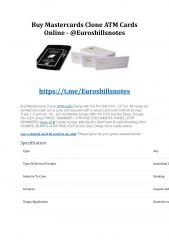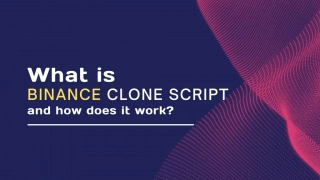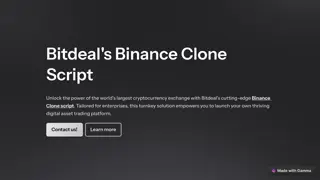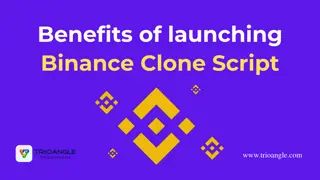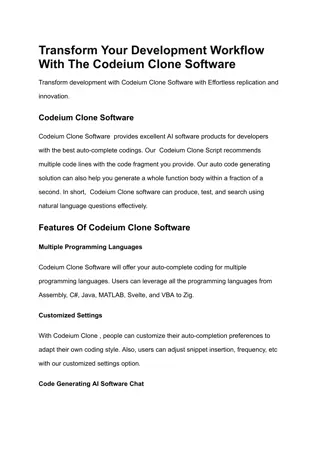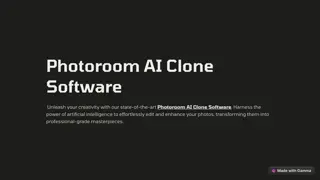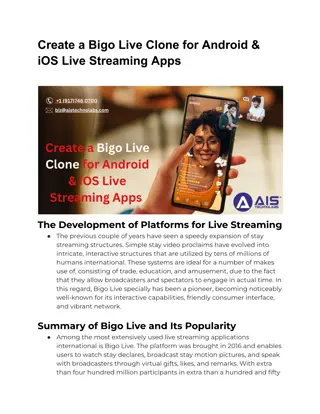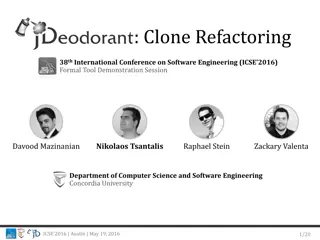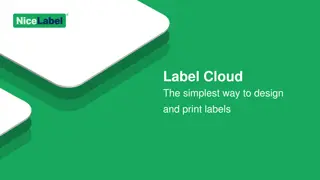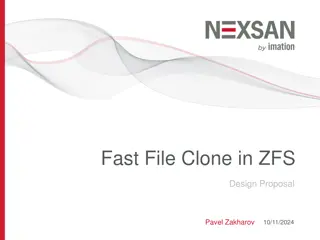Supporting Clone Analysis with Tag Cloud Visualization
"Code clones in software make maintenance complex. Tool support is crucial for analyzing code clones efficiently. Scatterplot and lexical information aid in understanding code clone distribution. Tag cloud visualization enhances keyword metadata retrieval."
Download Presentation

Please find below an Image/Link to download the presentation.
The content on the website is provided AS IS for your information and personal use only. It may not be sold, licensed, or shared on other websites without obtaining consent from the author.If you encounter any issues during the download, it is possible that the publisher has removed the file from their server.
You are allowed to download the files provided on this website for personal or commercial use, subject to the condition that they are used lawfully. All files are the property of their respective owners.
The content on the website is provided AS IS for your information and personal use only. It may not be sold, licensed, or shared on other websites without obtaining consent from the author.
E N D
Presentation Transcript
Supporting Clone Analysis with Tag Cloud Visualization Manamu Sano , Eunjong Choi , Norihiro Yoshida , Yuki Yamanaka , Katsuro Inoue Osaka University, Japan Nagoya University, Japan Software Engineering Laboratory, Department of Computer Science, Graduate School of Information Science and Technology, Osaka University
Code Clone A code fragment that has identical or similar ones to it in source code. It is widely believed that code clones make software maintenance more difficult. there may be the same bugs If there is a bug code clone clone set 2 Department of Computer Science, Graduate School of Information Science and Technology, Osaka University
Needs of Tool Support for Clone Analysis Large software system involves a lot of code clones. Checking code clones is necessary for refactoring and identifying license violations. It is unrealistic to check all code clones in software maintenance.[1] Tool support is necessary for clone analysis. 3 Department of Computer Science, Graduate School of Information Science and Technology, Osaka University [1] M. Rieger et al., Insights into system-wide code duplication, Proc. of WCRE, 2004.
Scatterplot A visualization technique for efficient grasp of parts involving a number of code clones. Developers readily know in which files or directories code clones exist by scatterplots. Axes files or directories of systems Points the presence or absence of a clone relation Example of scatterplots in Gemini [2]. 4 Department of Computer Science, Graduate School of Information Science and Technology, Osaka University [2] Ueda et al., Gemini: maintenance support environment based on code clone analysis, Proc. of 8th IEEE Symp. on Software Metrics, 2002.
Motivation Scatterplot provides only the location information of code clones. Developers cannot understand why code clones are concentrated in parts of a system. Lexical information provides a hint for understanding why those fragments are code clones. Existing tool using scatterplots do not use lexical information of code clones directly. lexical information: variable, function, type names in code clone 5 Department of Computer Science, Graduate School of Information Science and Technology, Osaka University
Tag Cloud It depicts keyword metadata for efficient understanding and information retrieval of given data. Advantages More keywords can be shown in a smaller area. Support instinctive understanding of important keywords. Example of tag cloud in natural language text. generated by Wordle (http://www.wordle.net/). 6 Department of Computer Science, Graduate School of Information Science and Technology, Osaka University
Proposed Tool CloneCloud A code clone analysis tool using scatterplot and tag cloud. Helps to : understand location of code clones. get a clue to the reason why code clones exist. input 3 kinds of views CCFinder[3] detecting code clones source files of Java system 7 Department of Computer Science, Graduate School of Information Science and Technology, Osaka University [3] Kamiya, et al., CCFinder: a multilinguistic token-based code clone detection system for large scale source code, IEEE Trans. Sofw. Eng., 2002.
Views of CloneCloud 1. Scatterplot View 2. Tag Cloud View 3. Source Code View scatterplot view tag cloud view source code view Example from Apache Ant (http://ant.apache.org/) rev. 1486439. 8 Department of Computer Science, Graduate School of Information Science and Technology, Osaka University
Scatterplot View1/2 Provides scatterplot of the input source files using Live Scatterplots[4]. vertical and horizontal axes directories of the input system color Clone Density between vertical and horizontal directories ?????????? ???????? ???????????? = ??????????: the set of tokens of code clones between the directories ???????? : the set of tokens of overall source code Low High 9 Department of Computer Science, Graduate School of Information Science and Technology, Osaka University [4] J. R. Cordy, Live Scatterplots, Proc. of IWSC 2011, 2011.
Scatterplot View2/2 Users can find directories where code clones are concentrated for clone refactoring. For example, focusing on the directories of red cells Tag Cloud View is popped up by selecting any cells. Low High 10 Department of Computer Science, Graduate School of Information Science and Technology, Osaka University
Tag Cloud View1/2 Shows identifier names in the selected directories in Scatterplot View. Red included in code clones of the directories Black contained only in the source code of the directories 11 Department of Computer Science, Graduate School of Information Science and Technology, Osaka University
Tag Cloud View2/2 Users can instinctively understand the role of the directories and get a clue for understanding code clones. It implements the functionality of ClearCase command. Example of the directory "optional/clearcase" in Apache Ant. Code clones are concentrated in the source code for argument creation of a command line. Red identifier names provide hyperlink to the Source Code View. 12 Department of Computer Science, Graduate School of Information Science and Technology, Osaka University
How to Generate Tag Cloud 1. Decide identifier names shown by tag cloud. Customize option : minimum sequence length minimum IDF values 2. Decide tag size based on TF-IDF[5]and coloring. Term Frequency Inverse Document Frequency ???? ?????? ????= log????? ?? ????= ??? ???? ???= ??? : an identifier name for sizing : the number of occurrences for ? ? ???? ?????? : the number of occurrences for all identifier names ????? : the number of all files ??? : the number of files including ? 13 Department of Computer Science, Graduate School of Information Science and Technology, Osaka University [5] R. A. Baeza-Yates et al., Modern information retrieval - the concepts and technology behind search, Second edition, Pearson Education Ltd., 2011.
Source Code View1/2 Shows the source code of the code clones that include the selected identifier names in the Tag Cloud View. selected identifier name code clones containing "createArgument" source code of the selected clone on the left pane, respectively code clones belonging to the same clone set 14 Department of Computer Science, Graduate School of Information Science and Technology, Osaka University
Source Code View2/2 Red Users can confirm the source code including selected identifier names. selected identifier name They can take a clue for understanding code clones that they are interested in. Green shown in Tag Cloud View 15 Department of Computer Science, Graduate School of Information Science and Technology, Osaka University
Summary Developed CloneCloud to support understanding code clones using tag cloud. Three kinds of views can provide a clue for understanding code clones. Future Work : Evaluating the usability of CloneCloud Comparing with existing clone visualization tools Applying to actual development of industry 16 Department of Computer Science, Graduate School of Information Science and Technology, Osaka University
